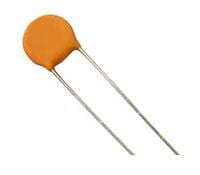




















Picofarad Capacitor (pF)
A picofarad (pF) capacitor is a unit of capacitance used to measure the electrical charge storage capacity of a capacitor. It is a very small unit of capacitance, equivalent to one trillionth (10^(-12)) of a farad (F), which is the standard unit of capacitance. Picofarads are often used to express the capacitance of small capacitors in electronic circuits.
Non-returnable
SKU - R0723
Rs.10.00
Values:
In stock:
0
Choose Quantity:
Share:
Product Details
Here are some key points about picofarad capacitors:
1. Capacitance Value: A picofarad (pF) capacitor has a capacitance value of 10^(-12) farads. In mathematical notation, 1 pF = 1 x 10^(-12) F.
2. Small Capacitance: Picofarad capacitors have very small capacitance values compared to capacitors in other common units like microfarads (µF) or nanofarads (nF). For example, a capacitor with a capacitance of 1 µF is equivalent to 1,000,000 picofarads (1 µF = 1,000,000 pF).
3. Applications: Picofarad capacitors are used in various electronic circuits and applications where small capacitance values are required. They are often used in high-frequency circuits, such as radio-frequency (RF) circuits, oscillators, and filters, where their small capacitance can have a significant impact.
4. Symbol: In circuit diagrams and schematics, capacitors are typically represented by the symbol "C," and the value of the capacitance (in picofarads, nanofarads, or microfarads) is usually specified nearby.
5. Tolerance: Like capacitors in other units, picofarad capacitors can come with tolerance values that indicate the allowable variation in capacitance from the specified value. Common tolerance values include ±5% and ±10%.
6. Dielectric Material: The dielectric material used in picofarad capacitors can vary depending on the specific application and requirements. Common dielectric materials include ceramic, polyester, polypropylene, and others.
7. Voltage Rating: Picofarad capacitors have voltage ratings that indicate the maximum voltage they can safely handle. It's essential to choose a capacitor with an appropriate voltage rating to prevent damage or failure in a circuit.
8. Package Size: Picofarad capacitors come in various package sizes and types, including through-hole and surface-mount components. The choice of package size depends on the specific application and available space on the circuit board.
9. Common Values: Common capacitance values in picofarads include 10 pF, 22 pF, 100 pF, 220 pF, and 1000 pF (1 nF).
10. Decade Prefixes: In electronic engineering, capacitance values can be expressed using prefixes to denote different orders of magnitude. For example, 1 pF is a picofarad, 1 nF is a nanofarad, and 1 µF is a microfarad.


